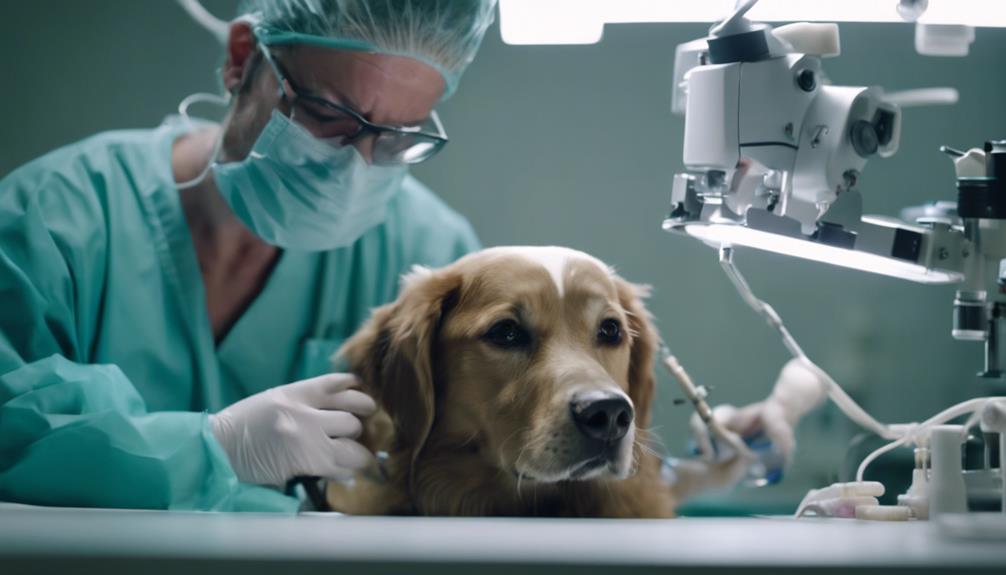The intricate interplay of causes, symptoms, diagnosis, and treatment concerning hydrocephalus in dogs presents a complex web that requires a nuanced understanding.
As we unravel the layers of this neurological condition, one cannot ignore the critical importance of early detection and tailored interventions to mitigate its detrimental effects.
From congenital origins to acquired instances, the journey through identifying the subtle signs to implementing effective strategies demands a comprehensive approach.
Stay tuned for a closer look at the multifaceted landscape of hydrocephalus in dogs and the intricate balance required for optimal management.
Key Takeaways
- Hydrocephalus in dogs can be congenital or acquired, with distinct causes and symptoms for each.
- Diagnosis involves physical characteristics like dome-shaped skulls and fontanels, along with imaging tests.
- Treatment options range from medications for mild cases to surgical shunt placement for severe cases.
- Regular veterinary monitoring and tailored care are essential for managing hydrocephalus in dogs effectively.
Understanding Hydrocephalus in Dogs
In dogs, hydrocephalus is characterized by the accumulation of cerebrospinal fluid (CSF) in the brain, a condition that plays a vital role in providing nutrients and cushioning delicate brain tissues. This buildup of CSF can lead to increased pressure on the brain, potentially causing severe brain damage if left untreated.
Hydrocephalus can be either congenital, present at birth due to abnormal fetal development, or acquired in adulthood with different underlying causes. Congenital hydrocephalus is more common and may manifest with dome-shaped skulls, wide-set eyes, and open fontanels in affected puppies.
Recognizing the symptoms, such as seizures, stupor, vision loss, and spastic walking, is crucial for prompt diagnosis and appropriate management of this condition.
Causes of Congenital Hydrocephalus
Congenital hydrocephalus in dogs arises from aberrations in brain development during the fetal stage, leading to the accumulation of cerebrospinal fluid (CSF) and subsequent neurological manifestations.
- Genetic predisposition
- Infections during pregnancy
- Maternal exposure to toxins
- Nutritional deficiencies
- Developmental abnormalities
These factors can disrupt the delicate balance of CSF production and absorption, resulting in the enlargement of fluid-filled spaces within the brain. Understanding these causes is crucial for early detection and intervention to improve the prognosis for dogs affected by congenital hydrocephalus.
Symptoms of Hydrocephalus in Puppies

Symptoms indicative of hydrocephalus in puppies typically manifest as neurological abnormalities and physical characteristics that signal potential brain dysfunction. Puppies with hydrocephalus may present with dome-shaped skulls, wide-set eyes, and open fontanels.
Neurologically, affected puppies may exhibit seizures, stupor, vision loss, and spastic walking. These symptoms reflect the increased intracranial pressure and potential brain damage associated with the condition.
Early recognition of these signs is crucial for prompt diagnosis and intervention to prevent further neurological deterioration. Monitoring for these hallmark symptoms in puppies, especially those predisposed to congenital hydrocephalus, can aid in timely treatment and better outcomes for affected individuals.
Acquired Hydrocephalus in Dogs
Understanding the distinct etiology of acquired hydrocephalus in dogs is crucial for accurate diagnosis and tailored treatment approaches. Acquired hydrocephalus differs from congenital cases and can develop in adulthood due to various reasons. Here are key points to consider:
- Head trauma or injury can lead to acquired hydrocephalus.
- Infections such as meningitis or encephalitis may cause the condition.
- Tumors in the brain can obstruct the flow of cerebrospinal fluid, resulting in hydrocephalus.
- Inflammatory conditions like granulomatous meningoencephalomyelitis (GME) can trigger fluid accumulation.
- Vascular diseases affecting blood flow in the brain can contribute to acquired hydrocephalus.
Diagnosis of Congenital Hydrocephalus

How can veterinarians accurately diagnose hydrocephalus in dogs with a congenital origin?
Diagnosing congenital hydrocephalus in dogs involves recognizing physical characteristics such as a dome-shaped head and open fontanel, along with observing clinical signs like seizures, stupor, vision impairment, and abnormal gait. Additionally, imaging techniques such as ultrasound, CT scans, and MRI are valuable tools in confirming the presence of excess cerebrospinal fluid and assessing the extent of brain abnormalities.
Unlike acquired hydrocephalus, which presents challenges due to symptom overlap with other conditions, congenital hydrocephalus diagnosis primarily relies on these physical traits and clinical manifestations. Early and accurate diagnosis is essential for initiating appropriate treatment and improving the prognosis for dogs with congenital hydrocephalus.
Challenges in Acquired Hydrocephalus Diagnosis
Diagnosing acquired hydrocephalus in dogs poses significant challenges due to the complexity of distinguishing its symptoms from those of other concurrent conditions. This difficulty can lead to delays in accurate diagnosis and appropriate treatment.
Some of the challenges faced in diagnosing acquired hydrocephalus include:
- Overlapping symptoms with neurological disorders.
- Lack of specific diagnostic tests for definitive confirmation.
- Variability in symptom presentation among individual dogs.
- Limited awareness among pet owners and even some veterinary professionals.
- Need for specialized imaging techniques for conclusive diagnosis.
Imaging Tests for Hydrocephalus Diagnosis

Challenges in accurately diagnosing acquired hydrocephalus in dogs necessitate the utilization of specialized imaging tests for conclusive confirmation. Imaging tests such as ultrasound, computed tomography (CT), and magnetic resonance imaging (MRI) play a crucial role in visualizing the brain structures and identifying any abnormalities associated with hydrocephalus.
Ultrasound is often used as a non-invasive initial screening tool due to its accessibility and cost-effectiveness, providing valuable insights into ventricular size and CSF flow. CT scans offer detailed cross-sectional images of the brain, aiding in the evaluation of ventricular enlargement and potential causes of acquired hydrocephalus.
MRI provides high-resolution images, facilitating the assessment of brain tissue changes and abnormalities, assisting veterinarians in confirming the diagnosis and planning appropriate treatment strategies.
CSF Analysis for Acquired Hydrocephalus
In the diagnostic process for acquired hydrocephalus in dogs, cerebrospinal fluid (CSF) analysis serves as a valuable tool for identifying underlying causes and guiding treatment decisions.
CSF analysis involves obtaining a sample of the fluid that surrounds the brain and spinal cord through a procedure called a spinal tap. This analysis provides crucial information about the composition of the CSF, helping veterinarians determine the specific cause of acquired hydrocephalus.
Key aspects evaluated in CSF analysis include protein levels, glucose levels, cell counts, and the presence of any infectious agents or abnormal cells. By interpreting these findings, veterinarians can tailor treatment plans to address the underlying condition effectively.
Early Treatment Importance

Early intervention in dogs diagnosed with hydrocephalus is paramount for effectively managing the condition and improving long-term outcomes. Prompt treatment can help alleviate symptoms, prevent further brain damage, and enhance the quality of life for affected dogs. Early identification of hydrocephalus allows for timely intervention, which may involve a combination of medications and surgical procedures tailored to the individual dog's needs. Below is a table summarizing the key aspects of early treatment importance in dogs with hydrocephalus:
| Benefits of Early Treatment | Implications of Delayed Treatment |
|---|---|
| – Halts CSF buildup | – Increased risk of brain damage |
| – Alleviates symptoms | – Worsening neurological deficits |
| – Improves long-term outcomes | – Reduced treatment effectiveness |
| – Enhances quality of life | – Higher likelihood of complications |
| – Tailored treatment plans | – Prolonged recovery period |
Medication Options for Hydrocephalus
When addressing hydrocephalus in dogs, exploring medication options plays a crucial role in managing symptoms and improving the overall quality of life for affected animals.
- Medications like steroids can help reduce inflammation in the brain.
- Diuretics may be prescribed to decrease the production of cerebrospinal fluid.
- Anti-seizure drugs can control and prevent seizures commonly associated with hydrocephalus.
- Osmotic agents may be used to reduce fluid accumulation in the brain.
- Pain management medications can help alleviate discomfort and improve the dog's well-being.
Surgical Intervention for Severe Cases

Exploring surgical options becomes imperative in cases of hydrocephalus in dogs that do not respond adequately to medication interventions. When severe symptoms persist despite medical management, surgical intervention may be necessary to alleviate the pressure on the brain caused by the buildup of cerebrospinal fluid (CSF).
One common surgical procedure for severe hydrocephalus cases in dogs is the placement of a ventriculoperitoneal shunt. This shunt helps divert excess CSF from the brain's ventricles to the abdominal cavity, where it can be reabsorbed harmlessly by the body.
Surgical intervention aims to reduce symptoms, improve the dog's quality of life, and prevent further neurological damage associated with untreated hydrocephalus. Regular monitoring post-surgery is essential to assess the shunt's effectiveness and address any complications promptly.
Conclusion
In conclusion, hydrocephalus in dogs is a neurological condition characterized by the abnormal accumulation of cerebrospinal fluid in the brain, leading to increased intracranial pressure and potential brain damage. Recognizing the causes, symptoms, and appropriate diagnostic methods are crucial for timely intervention.
Treatment options, including medication and surgical interventions, play a vital role in managing this condition. Vigilant monitoring and comprehensive care are essential for ensuring the well-being of canine patients with hydrocephalus.




